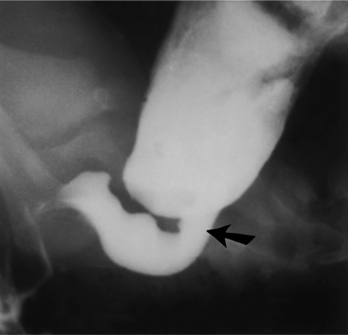CASE 30
After his birth, a newborn was placed in the hospital’s nursery. Within 24 hours of birth, the newborn developed abdominal distension and his vomitus contained bile. It was also noted that he had failed to pass meconium during this time. X-rays with a barium enema (Fig. 4-8) and a rectal biopsy lead to the diagnosis of Hirschsprung’s disease (congenital megacolon).
WHAT IS THE ARTERIAL SUPPLY TO THE RECTUM?
• Superior rectal artery. The superior part of the rectum is supplied by the superior rectal artery, a branch of the inferior mesenteric artery. The superior rectal artery divides into two branches that descend along the lateral walls of the rectum.
• Middle rectal artery. The middle and inferior parts of the rectum are supplied by two middle rectal arteries. Each middle rectal artery issues from the anterior division of the internal iliac artery. These arteries are frequently absent.
WHAT IS THE VENOUS DRAINAGE OF THE RECTUM?
• The superior rectal vein receives venous blood from the internal venous plexus and the superior part of the external rectal venous plexus. The superior rectal vein is a tributary of the inferior mesenteric vein.
• The middle rectal veins receive venous blood from the middle portion of the external rectal venous plexus. The middle rectal veins then drain into the internal iliac veins.




